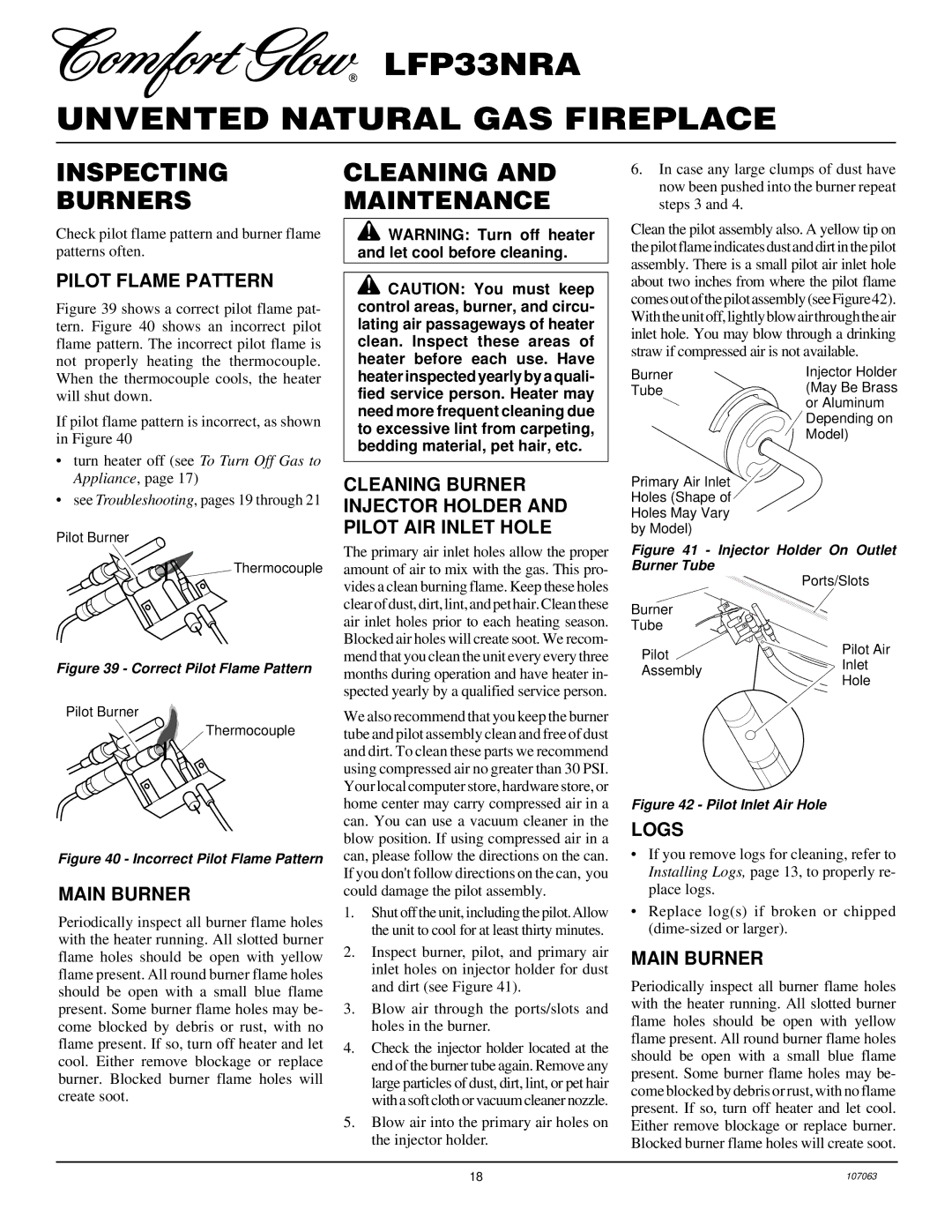
LFP33NRA
UNVENTED NATURAL GAS FIREPLACE
INSPECTING
BURNERS
Check pilot flame pattern and burner flame patterns often.
PILOT FLAME PATTERN
Figure 39 shows a correct pilot flame pat- tern. Figure 40 shows an incorrect pilot flame pattern. The incorrect pilot flame is not properly heating the thermocouple. When the thermocouple cools, the heater will shut down.
If pilot flame pattern is incorrect, as shown in Figure 40
•turn heater off (see To Turn Off Gas to Appliance, page 17)
•see Troubleshooting, pages 19 through 21
Pilot Burner
Thermocouple
Figure 39 - Correct Pilot Flame Pattern
Pilot Burner
Thermocouple
Figure 40 - Incorrect Pilot Flame Pattern
MAIN BURNER
Periodically inspect all burner flame holes with the heater running. All slotted burner flame holes should be open with yellow flame present. All round burner flame holes should be open with a small blue flame present. Some burner flame holes may be- come blocked by debris or rust, with no flame present. If so, turn off heater and let cool. Either remove blockage or replace burner. Blocked burner flame holes will create soot.
CLEANING AND MAINTENANCE
![]() WARNING: Turn off heater and let cool before cleaning.
WARNING: Turn off heater and let cool before cleaning.
![]() CAUTION: You must keep control areas, burner, and circu- lating air passageways of heater clean. Inspect these areas of heater before each use. Have heater inspected yearly by a quali- fied service person. Heater may need more frequent cleaning due to excessive lint from carpeting, bedding material, pet hair, etc.
CAUTION: You must keep control areas, burner, and circu- lating air passageways of heater clean. Inspect these areas of heater before each use. Have heater inspected yearly by a quali- fied service person. Heater may need more frequent cleaning due to excessive lint from carpeting, bedding material, pet hair, etc.
CLEANING BURNER INJECTOR HOLDER AND PILOT AIR INLET HOLE
The primary air inlet holes allow the proper amount of air to mix with the gas. This pro- vides a clean burning flame. Keep these holes clear of dust, dirt, lint, and pet hair. Clean these air inlet holes prior to each heating season. Blocked air holes will create soot. We recom- mend that you clean the unit every every three months during operation and have heater in- spected yearly by a qualified service person.
We also recommend that you keep the burner tube and pilot assembly clean and free of dust and dirt. To clean these parts we recommend using compressed air no greater than 30 PSI. Your local computer store, hardware store, or home center may carry compressed air in a can. You can use a vacuum cleaner in the blow position. If using compressed air in a can, please follow the directions on the can. If you don't follow directions on the can, you could damage the pilot assembly.
1.Shut off the unit, including the pilot.Allow the unit to cool for at least thirty minutes.
2.Inspect burner, pilot, and primary air inlet holes on injector holder for dust and dirt (see Figure 41).
3.Blow air through the ports/slots and holes in the burner.
4.Check the injector holder located at the end of the burner tube again. Remove any large particles of dust, dirt, lint, or pet hair with a soft cloth or vacuum cleaner nozzle.
5.Blow air into the primary air holes on the injector holder.
6.In case any large clumps of dust have now been pushed into the burner repeat steps 3 and 4.
Clean the pilot assembly also. A yellow tip on the pilot flame indicates dust and dirt in the pilot assembly. There is a small pilot air inlet hole about two inches from where the pilot flame comes out of the pilot assembly (see Figure42). With the unit off, lightly blow air through the air inlet hole. You may blow through a drinking straw if compressed air is not available.
Burner | Injector Holder |
Tube | (May Be Brass |
| or Aluminum |
| Depending on |
| Model) |
Primary Air Inlet Holes (Shape of Holes May Vary by Model)
Figure 41 - Injector Holder On Outlet Burner Tube
| Ports/Slots | |
Burner |
| |
Tube |
| |
Pilot | Pilot Air | |
Inlet | ||
Assembly | ||
Hole | ||
|
Figure 42 - Pilot Inlet Air Hole
LOGS
•If you remove logs for cleaning, refer to Installing Logs, page 13, to properly re- place logs.
•Replace log(s) if broken or chipped
MAIN BURNER
Periodically inspect all burner flame holes with the heater running. All slotted burner flame holes should be open with yellow flame present. All round burner flame holes should be open with a small blue flame present. Some burner flame holes may be- come blocked by debris or rust, with no flame present. If so, turn off heater and let cool. Either remove blockage or replace burner. Blocked burner flame holes will create soot.
18 | 107063 |
